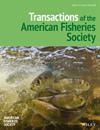Population assignment of migratory Westslope Cutthroat Trout (WCT) in the Clark Fork–Pend Oreille River Basin
IF 1.4
3区 农林科学
Q2 FISHERIES
引用次数: 0
Abstract
ObjectiveThe Clark Fork–Pend Oreille River basin of northeastern Washington and the Idaho Panhandle historically supported a robust metapopulation of the Westslope Cutthroat Trout (WCT)克拉克福克-彭德奥里尔河流域迁徙的西坡切喉鳟(WCT)的种群分布情况
目标华盛顿州东北部和爱达荷州潘汉德地区的克拉克福克-彭德奥里尔河流域历史上曾有一个强大的西坡切喉鳟(WCT)种群,这是一种具有很高文化和经济价值的西部本地鲑科鱼类。在过去的 100 年中,由于修建了无法逾越的水电大坝和较小的内流障碍,洄游的西坡切喉鳟无法返回产卵支流,导致该种群支离破碎。华盛顿州纽波特附近的阿尔贝尼瀑布大坝(AFD)就是这样一个不可逾越的障碍,该大坝于 1955 年建成,不具备鱼类通过能力。我们试图研究该研究区域的大规模遗传模式,并确定在 AFD 以下捕获的洄游 WCT 最有可能的产卵支流。我们的数据集包括 124 个集合,可用于检查整个研究区域的种群结构和孵化影响,并为种群分配提供了强有力的工具。尽管在整个研究区域内可能会受到孵化品系的影响,但所有来源不明的纯种 WCT 的种群分配测试都很成功。在AFD以下捕获的83条洄游WCT中,约80%被分配到AFD上游的支流,后分配概率至少为90%。结论我们的研究结果表明,AFD 破坏了该流域 WCT 种群的自然种群动态。在该障碍物处通过 WCT 将允许洄游个体对大坝上游的种群做出遗传贡献,从而重建流域内的种群连接。
本文章由计算机程序翻译,如有差异,请以英文原文为准。
求助全文
约1分钟内获得全文
求助全文
来源期刊
CiteScore
2.90
自引率
7.10%
发文量
48
审稿时长
8-16 weeks
期刊介绍:
Transactions of the American Fisheries Society is a highly regarded international journal of fisheries science that has been published continuously since 1872. It features results of basic and applied research in genetics, physiology, biology, ecology, population dynamics, economics, health, culture, and other topics germane to marine and freshwater finfish and shellfish and their respective fisheries and environments.

 求助内容:
求助内容: 应助结果提醒方式:
应助结果提醒方式:


